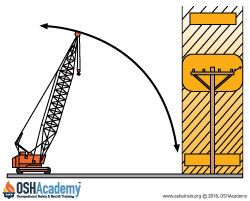Protection from Electrocution Hazards
Power Line Safety
When cranes and derrick operations are conducted around power lines, the employer must determine if any part of the equipment, load line or load (including rigging and lifting accessories), if operated up to the equipment's maximum working radius in the work zone, could get closer than 20 feet to a power line.
If so, the employer must meet one of the following requirements:
- Deenergize and ground. Confirm from the utility owner/operator that the power line has been deenergized and visibly grounded at the worksite.
- 20 foot clearance. Ensure that no part of the equipment, load line, or load (including rigging and lifting accessories), gets closer than 20 feet to the power line by implementing the measures specified in OSHA 1926.1408(b).
- Table A clearance. The minimum clearance distance when working around power lines up to 50kV is 10 feet. Click the button to review 1926.1408, Table A - Minimum Clearance Distances, that lists clearance distances for other power lines voltages.
| Voltage (nominal, kV, alternating current) | Minimum clearance distance (feet) | |
|---|---|---|
| Up to 50 | 10 | |
| Over 50 to 200 | 15 | |
| Over 200 to 350 | 20 | |
| Over 350 to 500 | 25 | |
| Over 500 to 750 | 35 | |
| Over 750 to 1000 | 45 | |
| Over 1000 | (As established by the power line owner/operator or registered professional engineer who is a qualified person with respect to electrical power transmission and distribution) | |
The following are preventive measures for workers to consider. Before work begins, make sure:
Overhead Work
- equipment/activity is located within a safe working distance from power lines;
- the utility company has de-energized and visibly grounded the power lines or installed insulated sleeves on power lines;
- flagged warning lines have been installed to mark horizontal and vertical power line clearance distances; and
- tools and materials used are nonconductive.
Knowledge Check Choose the best answer for the question.
2-1. According to 29 CFR 1926.1408(h), Table A - Minimum Clearance Distances, what is the minimum clearance distance for cranes and derricks when working around power lines up to 50kV?
You forgot to answer the question!

